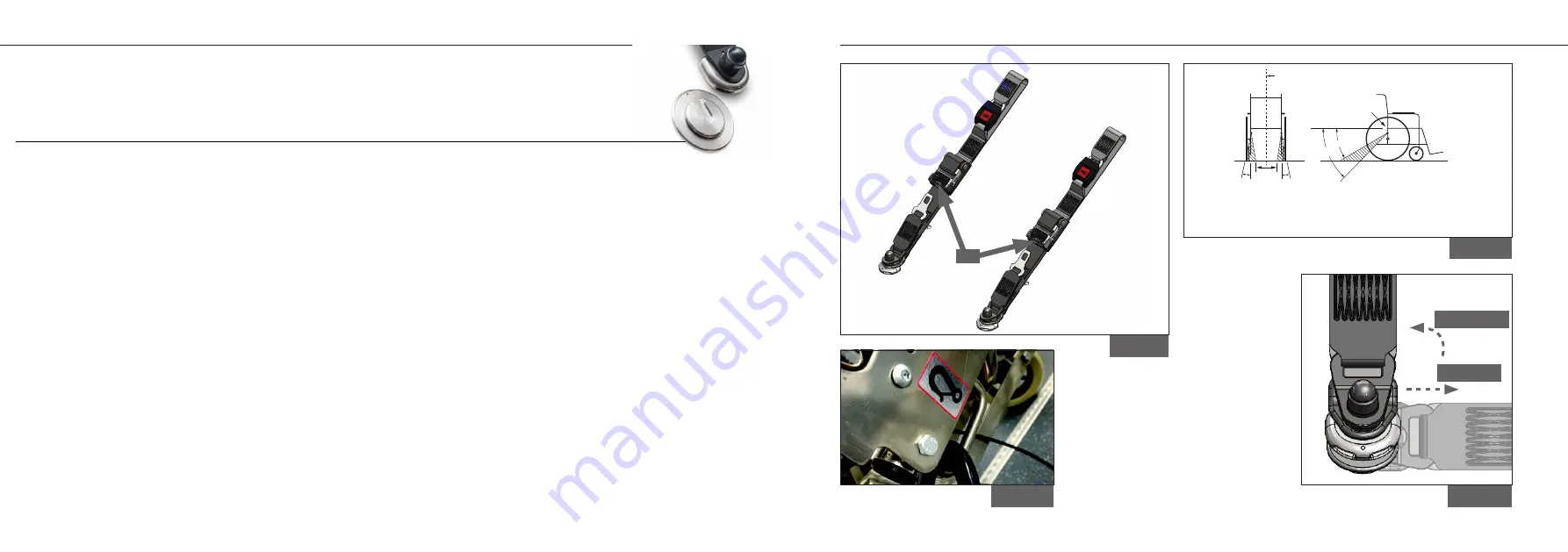
Figure 8
A - slide on
B - rotate 90°
Compact manual wheelchair tie-downs
Compact manual wheelchair tie-downs
Fi
t a
n
d u
se
16
17
Removing the compact manual
wheelchair tie-down
IMPORTANT: First remove the
occupant restraint, as instructed in the
relevant manual.
1.
Release the webbing tension in
each rear side by pressing the silver
release button on the over-centre
buckles and detach the karabiner,
J-hook or tongue and buckle
arrangement from the wheelchair’s
frame.
2. Remove each tie-down from the
anchor by rotating the tie-down
through 90°, (Fig. 8) so that the
raised protrusion on the cleat is
aligned with the indent on the floor
anchors, (Fig. 9). Slide off.
3. Pull the tie-down away from the
floor anchor and store safely.
Fit and use
Compact manual wheelchair tie-down
Solo anchor - rear
Figure 6
Figure 5
Rear
securement
points
Wheelchair
reference
plane
45°
30°
SIDE VIEW
REAR VIEW
10°
10°
300mm
(12in)
NOTE Note that angles indicated are obtained by projecting the angle of each tie-down strap
onto a vertical plane parallel to the wheelchair reference plane (side view) or onto a vertical
plane that is perpendicular to the wheelchair reference plane (rear view).
1.
Install the Quattro restraints onto the Solo anchors, in the same way as the
fronts.
2. When using tie-down with J-hooks or karabiners, ensure that the karabiner /
J-hook gates are facing outwards. If using tongue and buckle, the buckle may
be positioned facing inboard or outboard.
3. Remove the webbing from the Velcro patch and release the over-centre
buckle by pressing the silver button (Fig. 7A).
4. Attach the karabiner, J-hook or tongue and buckle arrangements around the
rear wheelchair frame to create an angle of around 30 to 45° within the rear
view zone, (Fig. 5). (Some wheelchairs will indicate this tie-down position, Fig.
6).
5. Pull the webbing through the over-centre buckle until it is tight. With the free
hand, begin to close the buckle. Once the webbing is retained, fully close the
buckle using both hands. Re-secure the Velcro to prevent the loose end from
becoming a trip hazard.
6. Similar tension should exist in all four tie-down webbings. Tension should be
such that the over centre buckle can be turned 90° in either direction using
moderate hand pressure. Adjust as necessary.
7. An occupant restraint should now be fitted.
Figure 7
A







































